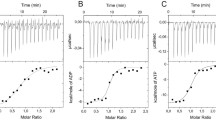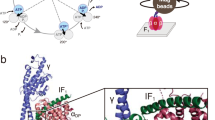Abstract
The F1 part of the ATP synthase contains 6 nucleotide binding sites, four of which can be occupied and covalently labeled with 8-azido-adenine nucleotides. The other two sites contain tightly bound nucleotides that cannot be replaced by 8-azido-adenine nucleotides. Of the four exchangeable sites two are directly ivolved in catalysis and these are located on β-subunits, while the other two are located at α-β interfaces and have probably a regulatory role by influencing the affinity of the catalytic sites for substrate and product. When only one catalytic site contains substrate the affinity is very high, the rate of hydrolysis is slow, and the dissociation of products is even slower (single-site catalysis). When the second site also becomes occupied, the affinity decreases enormously, and the rate of hydrolysis and dissociation of products increases several orders of magnitude. When, however, the second site is occupied by substrate in such a way that turnover is not possible at this site (e.g., covalent linkage of nitreno-ATP), the first site is no longer active, apart from the very slow single-site catalysis. The two nonexchangeable, tightly bound nucleotides that cannot be replaced by 8-azido-nucleotides, can be replaced by 2-azido-nucleotides, due to their anticonfiguration. This anticonfiguration of the substrate is also required for binding with high affinity to a catalytic site. A picture emerges in which one of the three α-β pairs of F1 contains tightly bound, nonexchangeable nucleotides, while the other two contain both one catalytic site (on β) and one regulatory site (at the α-β interface). Cooperativity exists both between the two catalytic sites and between the catalytic and the regulatory sites.
Similar content being viewed by others
References
Amzel, L. M., and Pedersen, P. L. (1978).J. Biol. Chem. 253, 2067–2069.
Andrews, W. W., Hill, F. C., and Allison, W. S. (1984).J. Biol. Chem. 259, 8219–8225.
Berden, J. A., and Voorn-Brouwer, M. M. (1978).Biochem. Biophys. Acta 501, 424–439.
Berden, J. A., van Dongen, M. B. M., Sloothaak, J. B., and Hartog, A. F. (1985). inAchievements and Perspectives of Mitochondrial Research (Quagliariello, E., Slater, E. C., Palmieri, F., Saccone, C., and Kroon, A. M., eds.), Elsevier, Amsterdam, Vol. I, pp. 257–267.
Boyer, P. D. (1984). InH> +-ATPase (ATP Synthase):Structure, Function, Biogenesis (Papa, S., Altendorf, K., Ernster, L., and Packer, L., eds.), Adriatica Editrice, Bari, pp. 329–338.
Boyer, P. D., Cross, R. L., and Momsen, W. (1973).Proc. Natl. Acad. Sci. USA 70, 2837–2839.
Cross, R. L., and Nalin, C. M. (1982).J. Biol. Chem. 257, 2874–2881.
Cross, R. L., Grubmeyer, C., and Penefsky, H. S. (1982).J. Biol. Chem. 257, 12101–12105.
Czarnecki, J. J., Abott, M. S., and Selman, B. R. (1982).Proc. Natl. Acad. Sci. USA 79, 7744–7748.
Ebel, R. E., and Lardy, H. A. (1975).J. Biol. Chem. 250, 191–196.
Esch, F. S., and Allison, W. S. (1979).J. Biol. Chem. 254 10740–10746.
Garret, N. E., and Penefsky, H. S. (1975a).J. Supramol. Struct. 3, 469–478.
Garret, N. E., and Penefsky, H. S. (1975b).J. Biol. Chem. 250, 6640–6647.
Gresser, M. J., Myers, J. A., and Boyer, P. D. (1982).J. Biol. Chem. 257, 12030–12038.
Grubmeyer, C., Cross R. L., and Penefsky, H. S. (1981).J. Biol. Chem. 257, 12092–12100.
Guillory, R. J. (1979).Curr. Topics Bioeng. 9, 267–414.
Harris, D. A., Rosing, J., van de Stadt, R. J., and Slater, E. C. (1973).Biochim. Biophys. Acta 314, 149–153.
Hollemans, M., Runswick, M. J., Fearnley, J. M., and Walker, J. E. (1983).J. Biol. Chem. 258, 9307–9313.
Knowles, A. L., and Penefsky, H. S. (1972).J. Biol. Chem. 247, 6617–6623.
Lunsdorf, H., Ehrig, K., Friedl, P., and Schairer, H. U. (1984).J. Mol. Biol. 173, 131–136.
Mitchell, P. (1966).Biol. Rev. 412, 445–502.
Mitchell, P. (1961).Nature 191, 144–148.
Montecucco, C., and Azzi, A. (1975).J. Biol. Chem. 250, 5020–5025.
Penefsky, H. S. (1985a).J. Biol. Chem. 260, 13728–13734.
Penefsky, H. S. (1985b).J. Biol. Chem. 260, 13735–13741.
Penefsky, H. S., Pullman, M. E., Datta, A., and Racker, E. (1960).J. Biol. Chem. 235, 3330–3336.
Recktenwald, D., and Hess, B. (1977).FEBS Lett. 76, 25–28.
Rosing, J., Harris, D. A., Slater, E. C., and Kemp, A. (1975a).J. Supramol. Struct. 3, 284–296.
Rosing, J., Harris, D. A., Kemp, A., and Slater, E. C. (1975b).Biochim. Biophys. Acta 376, 13–26.
Roveri, O. A., and Calcaterra, N. B. (1985).FEBS Lett., in press.
Senior, A. E., and Wise, J. G. (1983).J. Membr. Biol. 73, 105–124.
Slater, E. C. (1973). InDynamics of Energy-Transducing Membranes (L. Ernster, R. W. Estabrook, and E. C. Slater, eds.), Elsevier, Amsterdam, pp. 1–27.
Slater, E. C. (1979). InStructure and Function of Biomembranes (K. Yagi, ed.), Japan Scientific Society Press, pp. 211–217.
Slater, E. C., Berden, J. A., and Herweyer M. A. (1985).Biochim. Biophys. Acta 811, 217–231.
Sloothaak, J. B., Berden, J. A., Herweyer, M. A., and Kemp, A. (1985).Biochem. Biophys. Acta 809, 27–38.
Stutterheim, E., Henneke, M. A. C., and Berden J. A. (1980).Biochem. Biophys. Acta 592, 415–430.
Stutterheim, E., Henneke, M. A. C., and Berden, J. A. (1981).Biochim. Biophys. Acta 634, 271–278.
Sutton, R., and Ferguson, S. (1985).Eur. J. Biochem. 148, 551–554.
Tiedge, H., Schäfer, G., and Mayer, F. (1983).Eur. J. Biochem. 132, 37–45.
Todd, R. D., Griesenbeck, T. A., and Douglas, M. G. (1980).J. Biol. Chem. 255, 5461–5467.
Verschoor, G. J. (1982). Ph.D. Thesis, University of Amsterdam.
Wagenvoord, R. J., van der Kraan, I., and Kemp, A. (1977).Biochim. Biophys. Acta 460, 17–24.
Wagenvoord, R. J., van der Kraan, I., and Kemp, A. (1979).Biochem. Biophys. Acta 548, 85–95.
Walker, J. E., Fearnley, J. M., Gay, N. J., Gibson, B. W., Northrop, F. D., Powell, S. J., Runswick, M. J., Saraste, M., and Tybulewicz, V. L. J. (1985).J. Mol. Biol. 184, 677–702.
Westerhoff, H. V., Melandri, B. A., Venturoli, G., Azzone, G. F., and Kell, D. B. (1984).Biochim. Biophys. Acta 768, 257–292.
Wise, J. G., Latchney, L., and Senior, A. E. (1981).J. Biol. Chem. 256, 10383–10389.
Author information
Authors and Affiliations
Rights and permissions
About this article
Cite this article
Slater, E.C., Berden, J.A. & van Dongen, M.B.M. The mechanism of action of mitochondrial ATPase (ATP synthase). J Protein Chem 5, 177–192 (1986). https://doi.org/10.1007/BF01025487
Received:
Published:
Issue Date:
DOI: https://doi.org/10.1007/BF01025487




